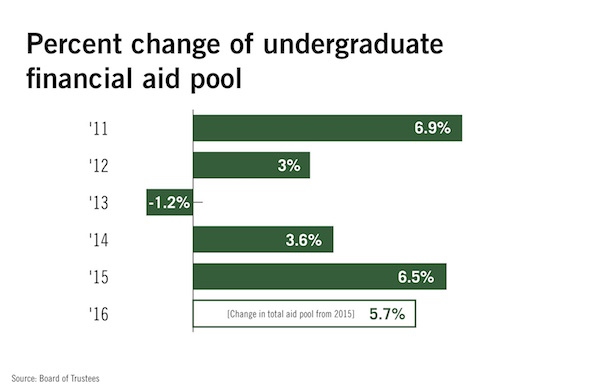Officials plan to award about $25 million more in financial aid next academic year.
The Board of Trustees approved more than $275 million in total financial aid Friday, an increase of more than 5 percent from last year. Officials attributed the increase to rising enrollment and students’ growing financial need.
University spokeswoman Maralee Csellar said more than 70 percent of the total aid will be distributed to undergraduates, totaling at least $192.5 million. That number would represent a 5.6 percent increase from the $182 million in financial aid that undergraduate students received last year.
The increase continues the board’s overall trend of boosting the size of the financial aid pool, which it has done 10 of the last 12 years.
“The University increased the financial aid pool because of an increase in tuition pricing, increased enrollment and the anticipation of an increase in the number of students requiring aid,” Csellar said.
The growth of the financial aid pool this year outpaces tuition growth, which will increase about 3 percent next academic year to $51,875 for incoming students.
In March, officials said they hoped to recruit about the same size freshman class as last year, but since they will replace a smaller graduating class, total undergraduate enrollment is still projected to increase. The University is expected to reach 99.8 percent of the full-time student population cap this fall.
Robert Kelchen, an assistant professor of higher education at Seton Hall University, said a swelling financial aid pool means officials are likely spending more money in financial aid to attract prospective students – meaning less money coming back into the university through tuition.
GW’s operating revenue is about 75 percent reliant on tuition.
“You want tuition revenue increasing when you’re at a tuition-reliant University,” Kelchen said.
Richard Vedder, an economics professor at Ohio University who specializes in higher education finance, said financial aid has become a form of competition between peer institutions, which attempt to lure in students with attractive financial packages.
“Maybe the reason financial aid is going up is just we need more kids here and if they’re being offered money in other places, we have to offer scholarships and more aid,” he said.
Vedder said GW is following a national trend over the last several years of colleges increasing both tuition and financial aid, but growing the financial aid pool at a much higher rate.
In the last few years, officials have increased accessibility in admissions and brought more low-income and minority students to campus. As part of that effort, officials switched to a test-optional policy this year, no longer mandating that undergraduate applicants submit standardized test scores.
The University received a record number of applications from low-income and minority students as part of a 28 percent surge in applications this year.
Vedder said increasing the population of lower-income students at GW likely contributed to the rise in financial aid.
“Schools like GW have been criticized as being white elitists, and there has been pressure on them, and this is the way they are dealing with it,” he said. “My guess is that it will led to aggressive increases in aid for lower-income students.”





